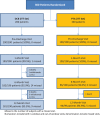Stellarex Drug-Coated Balloon for Treatment of Femoropopliteal Disease: Twelve-Month Outcomes From the Randomized ILLUMENATE Pivotal and Pharmacokinetic Studies
- PMID: 28729250
- PMCID: PMC5598919
- DOI: 10.1161/CIRCULATIONAHA.117.028893
Stellarex Drug-Coated Balloon for Treatment of Femoropopliteal Disease: Twelve-Month Outcomes From the Randomized ILLUMENATE Pivotal and Pharmacokinetic Studies
Abstract
Background: Drug-coated balloons (DCBs) are a predominant revascularization therapy for symptomatic femoropopliteal artery disease. Because of the differences in excipients, paclitaxel dose, and coating morphologies, varying clinical outcomes have been observed with different DCBs. We report the results of 2 studies investigating the pharmacokinetic and clinical outcomes of a new DCB to treat femoropopliteal disease.
Methods: In the ILLUMENATE Pivotal Study (Prospective, Randomized, Single-Blind, U.S. Multi-Center Study to Evaluate Treatment of Obstructive Superficial Femoral Artery or Popliteal Lesions With A Novel Paclitaxel-Coated Percutaneous Angioplasty Balloon), 300 symptomatic patients (Rutherford class 2-4) were randomly assigned to DCB (n=200) or standard angioplasty (percutaneous transluminal angioplasty [PTA]) (n=100). The primary safety end point was freedom from device- and procedure-related death through 30 days, and freedom from target limb major amputation and clinically driven target lesion revascularization through 12 months. The primary effectiveness end point was primary patency through 12 months. In the ILLUMENATE PK study (Pharmacokinetic Study of the Stellarex Drug-Coated Angioplasty Balloon), paclitaxel plasma concentrations were measured after last DCB deployment and at prespecified times (at 1, 4, 24 hours and at 7 and 14 days postprocedure) until no longer detectable.
Results: In the ILLUMENATE Pivotal Study, baseline characteristics were similar between groups: 50% had diabetes mellitus, 41% were women, mean lesion length was 8.3 cm, and 44% were severely calcified. The primary safety end point was met (92.1% for DCB versus 83.2% for PTA, P=0.025 for superiority) and the primary patency rate was significantly higher with DCB (76.3% for DCB versus 57.6% for PTA, P=0.003). Primary patency per Kaplan-Meier estimates at day 365 was 82.3% for DCB versus 70.9% for PTA (P=0.002). The rate of clinically driven target lesion revascularization was significantly lower in the DCB cohort (7.9% versus 16.8%, P=0.023). Improvements in ankle-brachial index, Rutherford class, and quality of life were comparable, but the PTA cohort required twice as many revascularizations. Pharmacokinetic outcomes showed that all patients had detectable paclitaxel levels after DCB deployment that declined within the first hour (54.4±116.9 ng/mL to 1.4±1.0 ng/mL).
Conclusions: The data demonstrate superior safety and effectiveness of the Stellarex DCB in comparison with PTA, and plasma levels of paclitaxel fall to low levels within 1 hour.
Clinical trial registration: URL: http://clinicaltrials.gov. Unique identifiers: NCT01858428 and NCT01912937.
Keywords: angioplasty; drug-eluting balloon; femoropopliteal; intermittent claudication; paclitaxel; peripheral arterial disease.
© 2017 The Authors.
Figures




References
-
- Criqui MH, Aboyans V. Epidemiology of peripheral artery disease. Circ Res. 2015;116:1509–1526. doi: 10.1161/CIRCRESAHA.116.303849. - PubMed
-
- Criqui MH, Browner D, Fronek A, Klauber MR, Coughlin SS, Barrett-Connor E, Gabriel S. Peripheral arterial disease in large vessels is epidemiologically distinct from small vessel disease. An analysis of risk factors. Am J Epidemiol. 1989;129:1110–1119. - PubMed
-
- Gerhard-Herman MD, Gornik HL, Barrett C, Barshes NR, Corriere MA, Drachman DE, Fleisher LA, Fowkes FG, Hamburg NM, Kinlay S, Lookstein R, Misra S, Mureebe L, Olin JW, Patel RA, Regensteiner JG, Schanzer A, Shishehbor MH, Stewart KJ, Treat-Jacobson D, Walsh ME. 2016 AHA/ACC Guideline on the Management of Patients With Lower Extremity Peripheral Artery Disease: Executive Summary: A Report of the American College of Cardiology/American Heart Association Task Force on Clinical Practice Guidelines. Circulation. 2017;135:e686–e725. doi: 10.1161/CIR.0000000000000470. - PMC - PubMed
-
- Matsumura JS, Yamanouchi D, Goldstein JA, Pollock CW, Bosiers M, Schultz GA, Scheinert D, Rocha-Singh KJ. The United States study for evaluating endovascular treatments of lesions in the superficial femoral artery and proximal popliteal by using the Protégé EverfLex Nitinol Stent System II (DURABILITY II). J Vasc Surg. 2013;58:73–83.e1. doi: 10.1016/j.jvs.2012.12.066. - PubMed
-
- Laird JR, Katzen BT, Scheinert D, Lammer J, Carpenter J, Buchbinder M, Dave R, Ansel G, Lansky A, Cristea E, Collins TJ, Goldstein J, Cao AY, Jaff MR RESILIENT Investigators. Nitinol stent implantation vs. balloon angioplasty for lesions in the superficial femoral and proximal popliteal arteries of patients with claudication: three-year follow-up from the RESILIENT randomized trial. J Endovasc Ther. 2012;19:1–9. doi: 10.1583/11-3627.1. - PubMed
Publication types
MeSH terms
Substances
Associated data
LinkOut - more resources
Full Text Sources
Other Literature Sources
Medical
Miscellaneous

